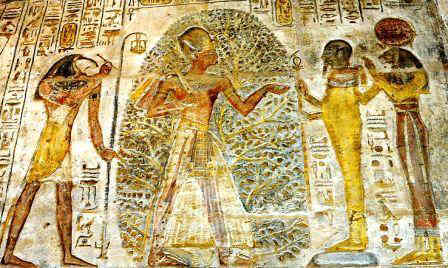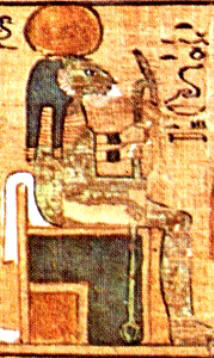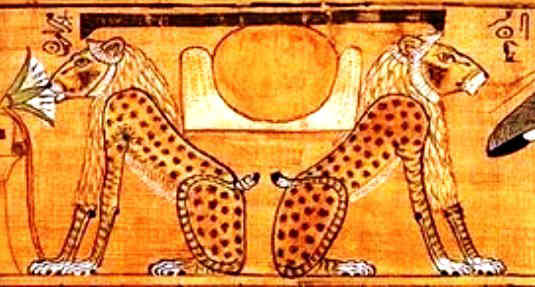
| Tefnut, goddess of Egypt | 
|
|
Ancient Egyptian Gods and Goddesses for kids - Tefnut The Mythology & History of ancient Egypt surrounding Tefnut, the goddess of rain and moisture |
|
Tefnut, goddess of Egypt
Discover the legends and myths and religious beliefs surrounding Tefnut, the Egyptian goddess of rain and moisture. Atum, the creator sun god, spat out the elements of moisture and air that became the Goddess Tefnut and the God Shu, who were referred to as the 'twin lion gods' and Tefnut is depicted in ancient Egyptian art with the head of a lioness. Tefnut took her brother Shu as her consort and they had two children Geb and Nut. This quartet of Egyptian gods represented the earth (Geb), the sky (Nut) the air (Shu) and Tefnut represented water. Additional, interesting facts and information about ancient Egypt, and its mysterious gods and goddesses, is also available via: |
|
Who was Tefnut?
Tefnut was the Egyptian goddess of rain, water and moisture. Egyptian gods and goddesses closely resembled the appearance of humans, many of their gods, like Tefnut, were also perceived as 'human hybrids' depicted with human bodies with the heads of animals. The ancient Egyptians did not usually worship animals, these symbols were used as a recognition aid, a device to visually convey the powers, identity and attributes of the deity. Tefnut was depicted with the body of a woman and the head of Lioness. Facts about Tefnut
The following facts and profile provides a fast overview of Tefnut:
Tefnut Profile & Fact File | | Egyptian Name: |
Alternative names: Tefnet, Tefenet, Tphenis (Greek)
| | Role & Function: | The function of Tefnut is described as being the lioness goddess of rain, water and moisture
| | Status: | Tefnut was a member of the Ennead, the name given to the nine original, most important, Egyptian Gods and Goddesses of the cosmogony of Heliopolis (the birthplace of the Gods)
| | Symbols: | Head of a lioness, ankh and 'was scepter'
| | Gender: | Female
| | Name of Consort: | Shu, also her brother
| | Name of Father: | Emerged from the moisture spat out by the Creator god, Atum
| | Names of Children: | Geb, god of the earth and Nut, goddess of the sky
|
|
|
Depictions of Tefnut in Egyptian Art
The pictures and depictions of Tefnut in ancient Egyptian art can be found in the tombs, temples, manuscripts and hieroglyphics, artefacts and relics of ancient Egypt. The people of ancient Egypt were able to recognise and distinguish their numerous gods and goddesses by their depictions in art understanding the meanings of colors and symbols which conveyed information about the deity. The following facts and information will enable you to decipher the art of ancient Egypt and understand the meanings behind the pictures of Tefnut. - Egyptian Goddesses, like Tefnut, were painted in a yellowish color indicating an indoor lifestyle, out of the sun
- Normally depicted with the head of a lioness
- Crown, or headdress: The Sun Disk her divine, royal status and association with Ra (Atum-Ra) the solar deity and the Uraeus, the protective rearing cobra
- Tefnut is often depicted holding the Ankh, the key of life, that represented eternal life
- She often holds the 'was' sceptre, a long staff, topped with a symbolic animal head, believed to embody magical powers, symbolizing divine power and an emblem of authority
Tefnut in Egyptian Mythology - Twin Sister of the god Shu
Tefnut, the Egyptian goddess of rain and moisture, featured in the stories, myths and legends in Egyptian Mythology. Tefnut was the twin-sister of Shu. Tefnut could take on the role of the 'Eye of Ra'. According to Egyptian mythology her brother Shu was the right eye of Atum Ra representing an aspect of the Sun and Tefnut was the left eye representing the Moon. In the creation myth the god Atum Ra says, after describing how Shu and Tefnut followed from himself, "thus from being one god I became three." She was also a god of the dead and connected with the supply of drink to the deceased. Tefnut and Shu were also worshipped as a pair of lions at Leontopolis in the Nile delta but her principal sanctuary was at Heliopolis. |
|
Tefnut- Interesting research information and Facts about the ancient Egyptian goddess
- Tefnut, the Egyptian goddess of rain and moisture
- Stories and Legends in Egyptian Mythology associated with the goddess of water
- Facts and information about the gods and deities of of classical Egypt for schools, research and kids
- Tefnut, the Egyptian goddess of rain and moisture
|
| | |
|
Picture of Tefnut and the Tree of Life
The following picture depicts a scene from the tomb of Ramses II who stands in the Tree of Life. On the left is the ibis-headed god Thoth, the secretary of the sun god Ra and scribe of the Underworld, the god Ptah, the lord of truth and Tefnut, the lion headed goddess. 
The Tree of Life Facts about Tefnut in Egyptian Mythology
Discover interesting information and research facts about Tefnut, the Egyptian goddess of rain and moisture. The facts about Tefnut provides a list detailing fascinating additional info to increase your knowledge about Tefnut in Egyptian Mythology. Mythology and Facts about Tefnut |
Fact 1 about Tefnut: |
Tefnut, the lion headed goddess of water, is often depicted on the coffins of the deceased pouring drink from a pitcher, to sustain the souls journeying through the Underworld.
| | Fact 2 about Tefnut: | She was also a god of the dead and connected with the supply of drink to the deceased. She is featured in depictions in the Book of the Dead
| | Fact 3 about Tefnut: | She was depicted as a lioness, or in human form, with the head of a
lioness
| | Fact 4 about Tefnut: | She could also be depicted as a snake coiled about a scepter.
| | Fact 5 about Tefnut: | She was also known as the "Uraeus on the Head of all the Gods" and the "Lady of the Flame"
| | Fact 6 about Tefnut: | According to ancient Egyptian mythology she argued with her father and left Egypt for Nubia. Only the god Thoth could persuade her to return
| | Fact 7 about Tefnut: | Tefnut became a goddess of the Underworld (Duat) and presided as two of the 42 judges in the ceremony of justification in the Hall of the Two Truths
| | Fact 8 about Tefnut: | According to ancient Egyptian mythology Shu and Tefnut laid the foundations of the house in which the deceased would dwell. The deceased drank from the water of Tefnut.
|

Tefnut, the lion goddess Tefnut - The Temples at Leontopolis
Leontopolis was the name of the ancient city where all the lion-headed and cat-headed gods associated with Ra the sun god were worshipped. Tefnut, the twin-sister of Shu were worshipped as a pair of lions at Leontopolis in the central area of the Nile delta, its ancient Egyptian name was Taremu. The Greek name of this city means, "City of Lions" as there were many temples dedicated to lion deities which contained live lions and cats. Aelian (ca. 175 – ca. 235), an ancient Roman historian wrote: "In Egypt, they worship lions, and there is a city called after them. The lions have temples and numerous spaces
in which to roam; the flesh of oxen is supplied to them daily and the lions eat to the accompaniment
of song in the Egyptian language" The Lion gods worshipped at Leontopolis were mostly associated with the cults of the solar god Atum Ra or Ptah. The names of other gods worshipped at Leontopolis were Bastet, the famous cat goddess, Sekhmet, lioness of war, and Mihos (Maahes), the lion prince. Leontopolis was also associated with the Horus, who according to ancient Egyptian mythology changed himself into a lion. 
|
|
|
|